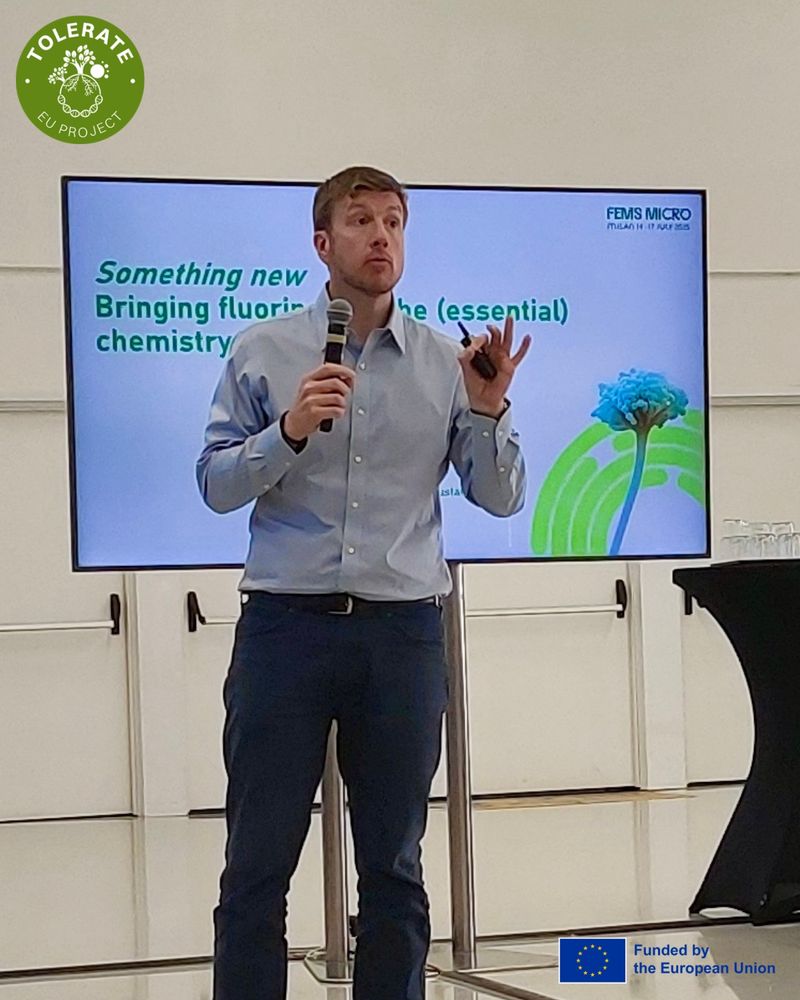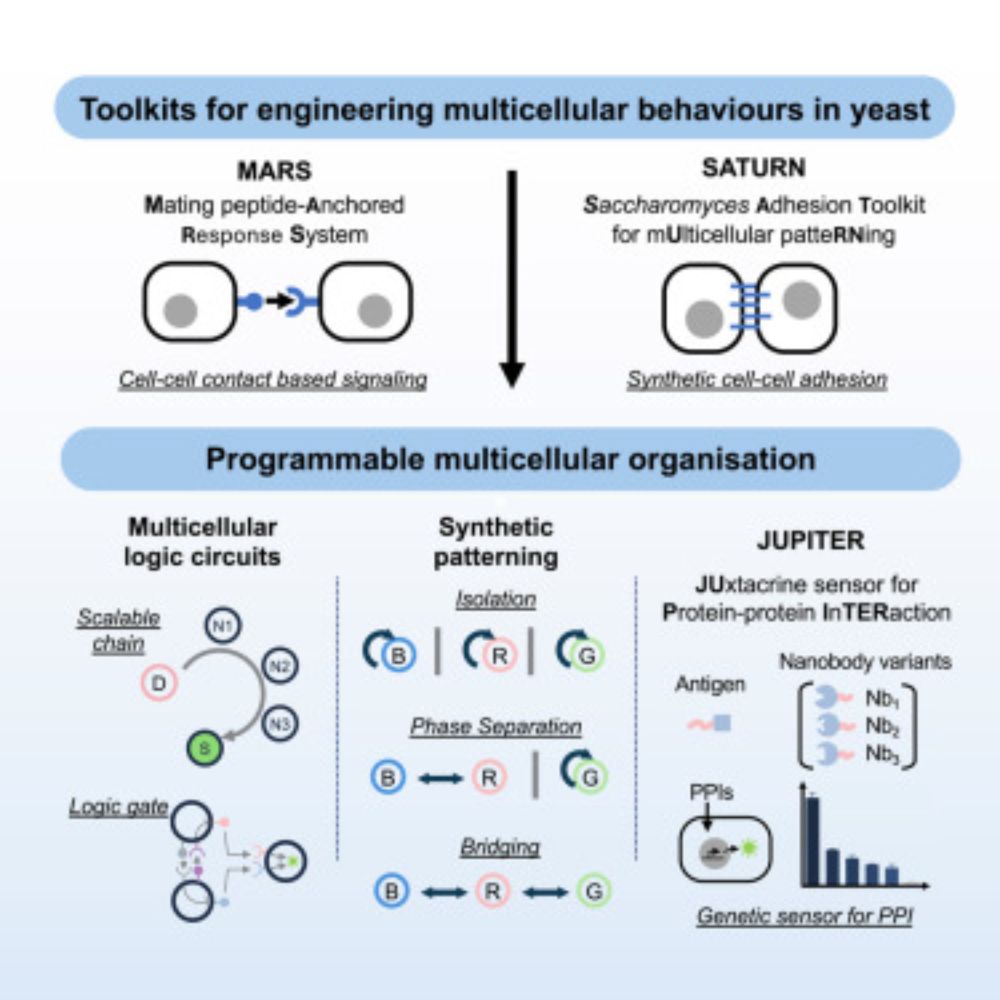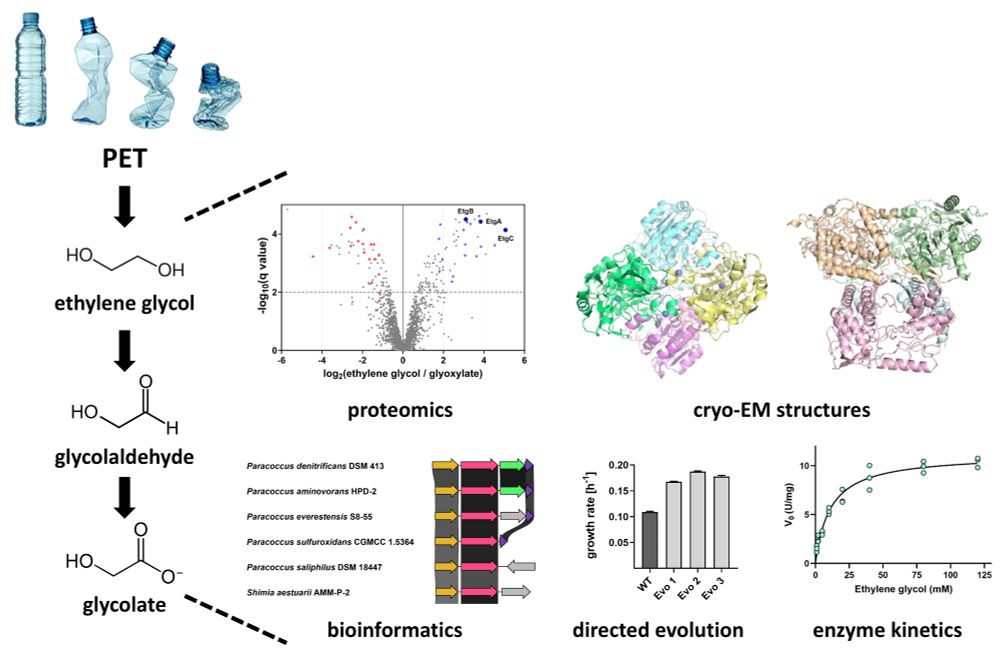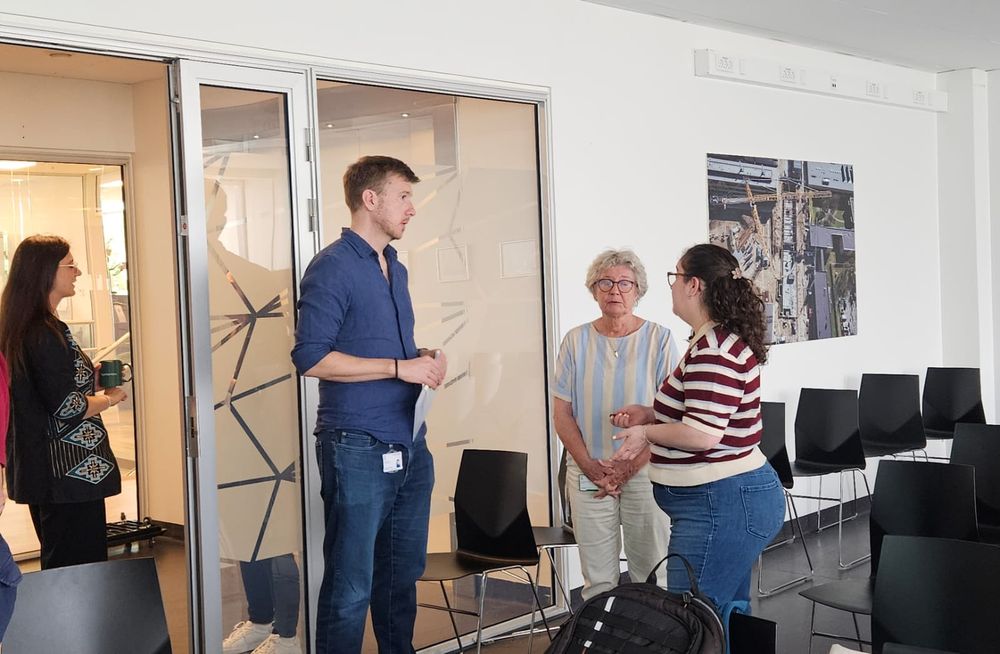@labnikel.bsky.social
Pinned

Integrated control of redox and energy metabolism by the membrane-bound and soluble transhydrogenases of Pseudomonas putida across metabolic regimes
Redox homeostasis is central to microbial physiology and stress adaptation, yet the functional roles of transhydrogenases remain poorly understood beyond a few organisms. In this study, we systematica...
www.biorxiv.org
How does Pseudomonas putida keep its redox balance steady across different metabolic states?
Our new preprint shows that two transhydrogenases -membrane-bound PntAB and soluble SthA - act together as a flexible, reversible system to control NAD(H)/NADP(H) ratios.
www.biorxiv.org/content/10.1...
Our new preprint shows that two transhydrogenases -membrane-bound PntAB and soluble SthA - act together as a flexible, reversible system to control NAD(H)/NADP(H) ratios.
www.biorxiv.org/content/10.1...
How does Pseudomonas putida keep its redox balance steady across different metabolic states?
Our new preprint shows that two transhydrogenases -membrane-bound PntAB and soluble SthA - act together as a flexible, reversible system to control NAD(H)/NADP(H) ratios.
www.biorxiv.org/content/10.1...
Our new preprint shows that two transhydrogenases -membrane-bound PntAB and soluble SthA - act together as a flexible, reversible system to control NAD(H)/NADP(H) ratios.
www.biorxiv.org/content/10.1...

Integrated control of redox and energy metabolism by the membrane-bound and soluble transhydrogenases of Pseudomonas putida across metabolic regimes
Redox homeostasis is central to microbial physiology and stress adaptation, yet the functional roles of transhydrogenases remain poorly understood beyond a few organisms. In this study, we systematica...
www.biorxiv.org
November 9, 2025 at 7:59 PM
How does Pseudomonas putida keep its redox balance steady across different metabolic states?
Our new preprint shows that two transhydrogenases -membrane-bound PntAB and soluble SthA - act together as a flexible, reversible system to control NAD(H)/NADP(H) ratios.
www.biorxiv.org/content/10.1...
Our new preprint shows that two transhydrogenases -membrane-bound PntAB and soluble SthA - act together as a flexible, reversible system to control NAD(H)/NADP(H) ratios.
www.biorxiv.org/content/10.1...
Reposted
Growth-coupled microbial biosynthesis of the animal pigment xanthommatin — Led by Leah Bushin, featuring M. Gracia Alvan, @danielvolke.bsky.social @oscarpuiggene.bsky.social in a fantastic collaboration w/Brad Moore @labnikel.bsky.social @natbiotech.nature.com 🦑
www.nature.com/articles/s41...
www.nature.com/articles/s41...

November 3, 2025 at 12:49 PM
Growth-coupled microbial biosynthesis of the animal pigment xanthommatin — Led by Leah Bushin, featuring M. Gracia Alvan, @danielvolke.bsky.social @oscarpuiggene.bsky.social in a fantastic collaboration w/Brad Moore @labnikel.bsky.social @natbiotech.nature.com 🦑
www.nature.com/articles/s41...
www.nature.com/articles/s41...
Reposted
🔥🔥🔥 Friday Evening, Paper Out, Feierabend 🔥🔥🔥
When evolution and enzyme engineering team up, they can convince microbes to assimilate sustainable carbon substrates preparing them for a life in a circular bioeconomy.
doi.org/10.1016/j.ym...
When evolution and enzyme engineering team up, they can convince microbes to assimilate sustainable carbon substrates preparing them for a life in a circular bioeconomy.
doi.org/10.1016/j.ym...
Redirecting
doi.org
October 24, 2025 at 5:00 PM
🔥🔥🔥 Friday Evening, Paper Out, Feierabend 🔥🔥🔥
When evolution and enzyme engineering team up, they can convince microbes to assimilate sustainable carbon substrates preparing them for a life in a circular bioeconomy.
doi.org/10.1016/j.ym...
When evolution and enzyme engineering team up, they can convince microbes to assimilate sustainable carbon substrates preparing them for a life in a circular bioeconomy.
doi.org/10.1016/j.ym...
🚀 Thrilled to share our new Nature Communications article:
“A blueprint for designing the next-generation of synthetic C1 microbes”
We propose a framework to unlock sustainable, carbon-efficient biomanufacturing using non-canonical hosts.
🔗 www.nature.com/articles/s41... A short 🧵1/4
“A blueprint for designing the next-generation of synthetic C1 microbes”
We propose a framework to unlock sustainable, carbon-efficient biomanufacturing using non-canonical hosts.
🔗 www.nature.com/articles/s41... A short 🧵1/4

A blueprint for designing the next-generation of synthetic C1 microbes - Nature Communications
Synthetic one-carbon assimilation could contribute to a more sustainable and circular carbon economy, but much work in this field has focused on model microorganisms. Here the authors provide their perspective on the potential value of non-model microbes, and how that potential could be realised.
www.nature.com
October 8, 2025 at 9:10 AM
🚀 Thrilled to share our new Nature Communications article:
“A blueprint for designing the next-generation of synthetic C1 microbes”
We propose a framework to unlock sustainable, carbon-efficient biomanufacturing using non-canonical hosts.
🔗 www.nature.com/articles/s41... A short 🧵1/4
“A blueprint for designing the next-generation of synthetic C1 microbes”
We propose a framework to unlock sustainable, carbon-efficient biomanufacturing using non-canonical hosts.
🔗 www.nature.com/articles/s41... A short 🧵1/4
Reposted
From the microbial networks behind kombucha fermentation to engineered strains powering sustainable fuels, #FEMSYeastRes brings you high-quality studies with major relevance across the field. 📊 Read the journal's most-read papers for the first half of 2025 buff.ly/NLKSc4N

August 19, 2025 at 10:02 AM
From the microbial networks behind kombucha fermentation to engineered strains powering sustainable fuels, #FEMSYeastRes brings you high-quality studies with major relevance across the field. 📊 Read the journal's most-read papers for the first half of 2025 buff.ly/NLKSc4N
🚨 New paper in mBio!
We established strict formatotrophic & methylotrophic growth in engineered Pseudomonas putida via the reductive glycine pathway (rGlyP). journals.asm.org/doi/full/10....
Here’s a teaser of how we did it 🧵👇1/5
We established strict formatotrophic & methylotrophic growth in engineered Pseudomonas putida via the reductive glycine pathway (rGlyP). journals.asm.org/doi/full/10....
Here’s a teaser of how we did it 🧵👇1/5

Synthetic C1 metabolism in Pseudomonas putida enables strict formatotrophy and methylotrophy via the reductive glycine pathway | mBio
Soluble C1 feedstocks, such as formate and methanol, have gained attention as sustainable substrates for biotechnology, with the potential to reduce greenhouse gas emissions and reliance on sugar-based resources. Despite their promise, the metabolic ...
journals.asm.org
August 22, 2025 at 10:19 AM
🚨 New paper in mBio!
We established strict formatotrophic & methylotrophic growth in engineered Pseudomonas putida via the reductive glycine pathway (rGlyP). journals.asm.org/doi/full/10....
Here’s a teaser of how we did it 🧵👇1/5
We established strict formatotrophic & methylotrophic growth in engineered Pseudomonas putida via the reductive glycine pathway (rGlyP). journals.asm.org/doi/full/10....
Here’s a teaser of how we did it 🧵👇1/5
Reposted
#Synthetic C1 #metabolism in #Pseudomonas putida enables strict formatotrophy and methylotrophy via the reductive glycine pathway—led by J. Turlin, M. G. Alván, @oscarpuiggene.bsky.social w/@stefanodonati.bsky.social & @sebwenk.bsky.social @mbio.bsky.social #SynBio
journals.asm.org/doi/10.1128/...
journals.asm.org/doi/10.1128/...

Synthetic C1 metabolism in Pseudomonas putida enables strict formatotrophy and methylotrophy via the reductive glycine pathway | mBio
Soluble C1 feedstocks, such as formate and methanol, have gained attention as sustainable substrates for biotechnology, with the potential to reduce greenhouse gas emissions and reliance on sugar-based resources. Despite their promise, the metabolic ...
journals.asm.org
August 21, 2025 at 3:45 PM
#Synthetic C1 #metabolism in #Pseudomonas putida enables strict formatotrophy and methylotrophy via the reductive glycine pathway—led by J. Turlin, M. G. Alván, @oscarpuiggene.bsky.social w/@stefanodonati.bsky.social & @sebwenk.bsky.social @mbio.bsky.social #SynBio
journals.asm.org/doi/10.1128/...
journals.asm.org/doi/10.1128/...
Reposted
🌱💧 Can #bioaugmentation help crops beat drought?
Discover how the #TOLERATEproject is exploring microbial solutions to boost drought resilience in EU agriculture, sustainably and at scale.
👏 Great insights by Afnan Suleiman-Bioclear earth-
🔗 Read more: tolerate-eu-project.com/how-eu-toler...
Discover how the #TOLERATEproject is exploring microbial solutions to boost drought resilience in EU agriculture, sustainably and at scale.
👏 Great insights by Afnan Suleiman-Bioclear earth-
🔗 Read more: tolerate-eu-project.com/how-eu-toler...

How EU TOLERATE Project explores bioaugmentation to combat drought stress in agriculture - Cyprus Institute of Neurology & Genetics
Climate change is intensifying drought events, putting global food production under pressure. Within the EU-funded TOLERATE project, Work Package 3 (WP3), led by Bioclear earth, and in collaboration w...
tolerate-eu-project.com
August 5, 2025 at 8:38 AM
🌱💧 Can #bioaugmentation help crops beat drought?
Discover how the #TOLERATEproject is exploring microbial solutions to boost drought resilience in EU agriculture, sustainably and at scale.
👏 Great insights by Afnan Suleiman-Bioclear earth-
🔗 Read more: tolerate-eu-project.com/how-eu-toler...
Discover how the #TOLERATEproject is exploring microbial solutions to boost drought resilience in EU agriculture, sustainably and at scale.
👏 Great insights by Afnan Suleiman-Bioclear earth-
🔗 Read more: tolerate-eu-project.com/how-eu-toler...
Reposted
After a long sleep, environmental remediation with live biologics is back to the mainstream R&D agenda at this side of the pond. Wanna join and EU-wide on line conversation with bioremediation stakeholders this Nov 10? Express interest and register here 👉 forms.cloud.microsoft/e/b7xVz7dJcu

July 22, 2025 at 10:45 AM
After a long sleep, environmental remediation with live biologics is back to the mainstream R&D agenda at this side of the pond. Wanna join and EU-wide on line conversation with bioremediation stakeholders this Nov 10? Express interest and register here 👉 forms.cloud.microsoft/e/b7xVz7dJcu
Reposted
🌍 At #FEMSMicrobiology 2025, the TOLERATE team had the great pleasure of sharing insights from the TOLERATE project!
🧬 Our session sparked great discussions around ancient DNA and how we can revive, through synthetic biology, lost functions beneficial for future agriculture.
🧬 Our session sparked great discussions around ancient DNA and how we can revive, through synthetic biology, lost functions beneficial for future agriculture.



July 22, 2025 at 11:29 AM
🌍 At #FEMSMicrobiology 2025, the TOLERATE team had the great pleasure of sharing insights from the TOLERATE project!
🧬 Our session sparked great discussions around ancient DNA and how we can revive, through synthetic biology, lost functions beneficial for future agriculture.
🧬 Our session sparked great discussions around ancient DNA and how we can revive, through synthetic biology, lost functions beneficial for future agriculture.
Reposted
📍 Milan | TODAY!
Join Amedea Perfumo & @pabnik.bsky.social at #FEMS 2025 for a dynamic session🧬 "Something (very) old, something new: Innovative microbial solutions for sustainability challenges
🕦 15 July | 11:30–13:00 | Tower Lounge
🔗 femsmicro.org
▶️ youtu.be/0-bhcMpjJ_c
#TolerateEUProject
Join Amedea Perfumo & @pabnik.bsky.social at #FEMS 2025 for a dynamic session🧬 "Something (very) old, something new: Innovative microbial solutions for sustainability challenges
🕦 15 July | 11:30–13:00 | Tower Lounge
🔗 femsmicro.org
▶️ youtu.be/0-bhcMpjJ_c
#TolerateEUProject

July 15, 2025 at 5:51 AM
📍 Milan | TODAY!
Join Amedea Perfumo & @pabnik.bsky.social at #FEMS 2025 for a dynamic session🧬 "Something (very) old, something new: Innovative microbial solutions for sustainability challenges
🕦 15 July | 11:30–13:00 | Tower Lounge
🔗 femsmicro.org
▶️ youtu.be/0-bhcMpjJ_c
#TolerateEUProject
Join Amedea Perfumo & @pabnik.bsky.social at #FEMS 2025 for a dynamic session🧬 "Something (very) old, something new: Innovative microbial solutions for sustainability challenges
🕦 15 July | 11:30–13:00 | Tower Lounge
🔗 femsmicro.org
▶️ youtu.be/0-bhcMpjJ_c
#TolerateEUProject
Preprint finally published on @cp-trendsbiotech.bsky.social! Check out the word led by @oscarpuiggene.bsky.social on methanol assimilation in P. putida via enhanced serine–threonine cycle on www.cell.com/trends/biote...
Below, the original thread🧵scratching the surface of a long yet satisfying work!
Below, the original thread🧵scratching the surface of a long yet satisfying work!
July 13, 2025 at 3:04 PM
Preprint finally published on @cp-trendsbiotech.bsky.social! Check out the word led by @oscarpuiggene.bsky.social on methanol assimilation in P. putida via enhanced serine–threonine cycle on www.cell.com/trends/biote...
Below, the original thread🧵scratching the surface of a long yet satisfying work!
Below, the original thread🧵scratching the surface of a long yet satisfying work!
Reposted
Online now @ Cell is the yeast multicellular engineering paper from Fankang Meng - the fruits of his productive PhD in our group. He developed modular synthetic biology tools to bring multicellular behaviours to yeast - specific adhesion, juxtacrine signalling and more. www.cell.com/cell/fulltex...

Engineering yeast multicellular behaviors via synthetic adhesion and contact signaling
By designing synthetic toolkits for contact-based signaling (MARS) and cell-cell adhesion
(SATURN), we program yeast to form multicellular structures and perform complex tasks,
like building logic cir...
www.cell.com
July 11, 2025 at 3:01 PM
Online now @ Cell is the yeast multicellular engineering paper from Fankang Meng - the fruits of his productive PhD in our group. He developed modular synthetic biology tools to bring multicellular behaviours to yeast - specific adhesion, juxtacrine signalling and more. www.cell.com/cell/fulltex...
The 5th edition of the #Pseudomonas grass roots meeting will take place on the 27th/28th of October 2025 in Denmark. This year, our group at DTU Biosustain will host 2 exciting days of networking, exchanging ideas and learning for early career-stage scientists working with Pseudomonas. 👇

July 9, 2025 at 11:21 AM
The 5th edition of the #Pseudomonas grass roots meeting will take place on the 27th/28th of October 2025 in Denmark. This year, our group at DTU Biosustain will host 2 exciting days of networking, exchanging ideas and learning for early career-stage scientists working with Pseudomonas. 👇
Check out our newest article led by @oscarpuiggene.bsky.social !
Implementing synthetic serine cycles in #Pseudomonas putida unlock methanol assimilation in our favorite bug w/carbon conservation, led by ÒscarPuiggené @labnikel.bsky.social · #SynBio #MetabolicEngineering #Methanol published in @cp-trendsbiotech.bsky.social
www.sciencedirect.com/science/arti...
www.sciencedirect.com/science/arti...

Systematic engineering of synthetic serine cycles in Pseudomonas putida uncovers emergent topologies for methanol assimilation
The urgent need for a circular carbon economy has driven research into sustainable substrates, including one-carbon (C1) compounds. The non-pathogenic…
www.sciencedirect.com
July 9, 2025 at 11:15 AM
Check out our newest article led by @oscarpuiggene.bsky.social !
Reposted
🧫 @josephinegiard.bsky.social (HWU) presented #TOLERATE at the #MicrobiologySociety Early Career Conference 2025 in Newcastle 🇬🇧. Flash talk + poster led to great discussions on antifungal resistance with >10 peers & >50 attendees! 🌱
#TOLERATE #HorizonEurope #Microbiology
#TOLERATE #HorizonEurope #Microbiology


July 3, 2025 at 1:48 PM
🧫 @josephinegiard.bsky.social (HWU) presented #TOLERATE at the #MicrobiologySociety Early Career Conference 2025 in Newcastle 🇬🇧. Flash talk + poster led to great discussions on antifungal resistance with >10 peers & >50 attendees! 🌱
#TOLERATE #HorizonEurope #Microbiology
#TOLERATE #HorizonEurope #Microbiology
Reposted
New phi15-based expression system in Pseudomonas putida uses #SEVA plasmids for high-yield gene expression. The work by @pabnik.bsky.social shows how single-copy vectors minimise toxicity, achieve 200×induction, and outperform T7 systems. 👉 www.nature.com/articles/s42...

Engineering a phi15-based expression system for stringent gene expression in Pseudomonas putida - Communications Biology
The development of a modular, phage-based expression system optimized for Pseudomonas putida enables stringent, tunable and high yield expressions with minimal cytotoxicity.
www.nature.com
July 3, 2025 at 10:02 AM
New phi15-based expression system in Pseudomonas putida uses #SEVA plasmids for high-yield gene expression. The work by @pabnik.bsky.social shows how single-copy vectors minimise toxicity, achieve 200×induction, and outperform T7 systems. 👉 www.nature.com/articles/s42...
Reposted
Today, the #TOLERATEProject held its 1st Review Meeting (M1–M18) with PO & PM highlighting our progress, innovation & first results. A key step to shape the road ahead! 🔬🌱💦
Learn more: https://tolerate-eu-project.com/
#HorizonEurope #EUProjects #Biotechnology #SustainableAgriculture
Learn more: https://tolerate-eu-project.com/
#HorizonEurope #EUProjects #Biotechnology #SustainableAgriculture


June 30, 2025 at 1:02 PM
Today, the #TOLERATEProject held its 1st Review Meeting (M1–M18) with PO & PM highlighting our progress, innovation & first results. A key step to shape the road ahead! 🔬🌱💦
Learn more: https://tolerate-eu-project.com/
#HorizonEurope #EUProjects #Biotechnology #SustainableAgriculture
Learn more: https://tolerate-eu-project.com/
#HorizonEurope #EUProjects #Biotechnology #SustainableAgriculture
Reposted
Ethylene glycol is widely used as monomer of the plastic PET. It is therefore highly relevant as sustainable feedstock for microbial biotechnology. In our new paper in @natcomms.nature.com, we characterize efficient enzymes for ethylene glycol oxidation: www.nature.com/articles/s41...

July 1, 2025 at 2:57 PM
Ethylene glycol is widely used as monomer of the plastic PET. It is therefore highly relevant as sustainable feedstock for microbial biotechnology. In our new paper in @natcomms.nature.com, we characterize efficient enzymes for ethylene glycol oxidation: www.nature.com/articles/s41...
Back from an inspiring week at #ME16 in our home #Copenhagen! 🌍
Engaging talks, exciting science, and amazing connections — we’re full of new ideas!
🎉 Big congrats to @giusifav.bsky.social for winning a poster award 🏆
🙌 And proud to have our PI @pabnik.bsky.social as co-chair of the event!
Engaging talks, exciting science, and amazing connections — we’re full of new ideas!
🎉 Big congrats to @giusifav.bsky.social for winning a poster award 🏆
🙌 And proud to have our PI @pabnik.bsky.social as co-chair of the event!




June 23, 2025 at 8:14 AM
Back from an inspiring week at #ME16 in our home #Copenhagen! 🌍
Engaging talks, exciting science, and amazing connections — we’re full of new ideas!
🎉 Big congrats to @giusifav.bsky.social for winning a poster award 🏆
🙌 And proud to have our PI @pabnik.bsky.social as co-chair of the event!
Engaging talks, exciting science, and amazing connections — we’re full of new ideas!
🎉 Big congrats to @giusifav.bsky.social for winning a poster award 🏆
🙌 And proud to have our PI @pabnik.bsky.social as co-chair of the event!
Reposted
Happy to host @kunjapur.bsky.social as a sabbatical #professor at DTU Biosustain, supported by Otto Mønsteds Fond! We share a passion for using #SynBio to engineer #microbes with non-natural building blocks for advanced #biotechology. He’s in #Europe — drop a line to connect & discuss cool #Science!

June 9, 2025 at 9:00 AM
Happy to host @kunjapur.bsky.social as a sabbatical #professor at DTU Biosustain, supported by Otto Mønsteds Fond! We share a passion for using #SynBio to engineer #microbes with non-natural building blocks for advanced #biotechology. He’s in #Europe — drop a line to connect & discuss cool #Science!
Reposted
🎉 Excited to share that I’ve received an Emerging Investigator Grant from the Novo Nordisk Foundation! I’ll start my research group in Jan 2026 to develop universal cell factories for P2X & CO₂-based biomanufacturing 🌱🔬
👉 researchleaderprogramme.com/recipients/e...
👉 researchleaderprogramme.com/recipients/e...

June 3, 2025 at 1:56 PM
🎉 Excited to share that I’ve received an Emerging Investigator Grant from the Novo Nordisk Foundation! I’ll start my research group in Jan 2026 to develop universal cell factories for P2X & CO₂-based biomanufacturing 🌱🔬
👉 researchleaderprogramme.com/recipients/e...
👉 researchleaderprogramme.com/recipients/e...
Reposted
The TOLERATE team met at DTU (Denmark) for a productive General Assembly.
New coordinator Pablo Ivan Nikel opened the meeting, presenting the transition and confirming that the project continues full speed ahead.
More info 👉 tolerate-eu-project.com
Subscribe 👉 eepurl.com/i6uufM
#EUProjects
New coordinator Pablo Ivan Nikel opened the meeting, presenting the transition and confirming that the project continues full speed ahead.
More info 👉 tolerate-eu-project.com
Subscribe 👉 eepurl.com/i6uufM
#EUProjects




June 2, 2025 at 4:33 PM
The TOLERATE team met at DTU (Denmark) for a productive General Assembly.
New coordinator Pablo Ivan Nikel opened the meeting, presenting the transition and confirming that the project continues full speed ahead.
More info 👉 tolerate-eu-project.com
Subscribe 👉 eepurl.com/i6uufM
#EUProjects
New coordinator Pablo Ivan Nikel opened the meeting, presenting the transition and confirming that the project continues full speed ahead.
More info 👉 tolerate-eu-project.com
Subscribe 👉 eepurl.com/i6uufM
#EUProjects
Reposted
What a very cool work from the @fillouxlab.bsky.social alumni Sophie Howard and @ronanmccarthy.bsky.social . Plastic degrading #Pseudomonas aeruginosa and the threat it poses in nosocomial infections and to medical devices in healthcare system. See at rb.gy/c8s6mh @cp-cellreports.bsky.social

Pseudomonas aeruginosa clinical isolates can encode plastic-degrading enzymes that allow survival on plastic and augment biofilm formation
Howard et al. demonstrate that clinical isolates of the opportunistic pathogen Pseudomonas
aeruginosa can encode functional plastic-degrading enzymes and that these enzymes
can influence bacterial bio...
rb.gy
May 13, 2025 at 2:27 AM
What a very cool work from the @fillouxlab.bsky.social alumni Sophie Howard and @ronanmccarthy.bsky.social . Plastic degrading #Pseudomonas aeruginosa and the threat it poses in nosocomial infections and to medical devices in healthcare system. See at rb.gy/c8s6mh @cp-cellreports.bsky.social
Reposted
Solène’s 4.5 years of postdoctoral work in our lab (she started just before the corona pandemic) has now been published. A heroic effort that revealed -at the single molecule level- that ATP drives the dissociation of an ECF transporter complex under turnover conditions. See rdcu.be/elTKc

Single-molecule visualization of ATP-induced dynamics of the subunit composition of an ECF transporter complex under turnover conditions
Nature Communications - The association and dissociation dynamics of the ECF transporter complex for vitamin B12 are visualized by single-molecule FRET, highlighting the original transport...
rdcu.be
May 13, 2025 at 7:30 PM
Solène’s 4.5 years of postdoctoral work in our lab (she started just before the corona pandemic) has now been published. A heroic effort that revealed -at the single molecule level- that ATP drives the dissociation of an ECF transporter complex under turnover conditions. See rdcu.be/elTKc

